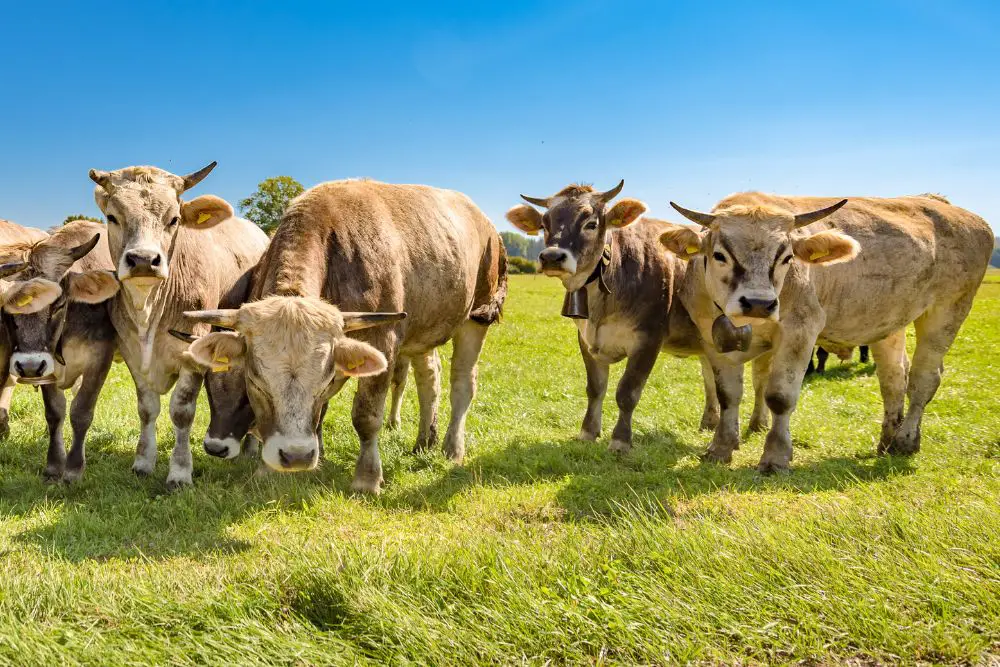Braunvieh cattle originate from cattle that date back to medieval times and are a hardy breed found in over 60 countries today, providing incredible milk and meat yields. Some confusion exists between Braunvieh and Brown Swiss cows, but the two breeds are one and the same.
They are known as an excellent beef breed by the beef industry but are likewise a dual-purpose breed known for milk production and high weaning weight of calves.
Table of Contents
Where Does The Braunvieh Come From?
Braunvieh cattle are originally from Switzerland and may be one of the oldest purebred cattle breeds in the world, with archeological evidence suggesting that they may date back to the Bronze Age.
The first known written records of Braunvieh cattle stem from Einsiedeln Monastery books, with evidence that Benedictine monks began breeding Braunvieh around 1000 years ago but the first herd book dates to 1775.
Further monastic records show the first known exportation of Braunvieh cattle occurred in the 14th century when they were exported to a mountainous region in Austria.
Braunvieh cattle were shown in expositions in Paris and London in 1855 and 1862 and gained international interest. The exportation of Swiss Braunvieh cattle to several different European countries and North America occurred following these events.
The herds brought to the United States were used only for milk production, and bred exclusively for milking qualities which led to the creation of a separate breed, given the name American Brown Swiss.
Interestingly, these American Brown Swiss were introduced back to the purebred Braunvieh in large numbers in the 1960s and according to the Braunvieh Association of America, the Braunvieh of today has 3/4ths of their genetics coming from the American Brown Swiss.
Fortunately, the pure Braunvieh still exists, albeit in limited numbers and is registered as Original Braunvieh or Original Schweizer Braunvieh.

There are now over 7 million head worldwide, with official breeders associations in 42 countries who remain committed to the continued upward trajectory of this all-star breed of cattle.
Braunvieh Cattle Breed Characteristics
| Official Breed Name | Original Braunvieh, Original Schweizer Braunvieh |
| Scientific Name | Bos taurus |
| Origin | Switzerland |
| Appearance | Body color comes in various shades of grey-brown Known for the light colored ring around their nose Medium size horns that curl outwards Excellent conformation, stout body and long, strong legs |
| Calf Weight | 65lbs to 120lbs |
| Mature Cow Weight | 1100lbs to 1500lbs |
| Mature Cow Height | 4.4 feet |
| Mature Bull Weight | 1800lbs to 2500lbs |
| Mature Bull Height | 4.9 feet |
| Ready To Breed | 13 to 15 months |
| Gestation Period | 283 days |
| First Calvings | 2 years |
| Time to Slaughter | 13 months |
| Carcass Weight | 595 to 628lbs |
| Expected Lifespan | 15 to 20 years |
| Productive Lifespan | 7+ years |
| Known For | Docile temperament and ease of handling Excellent milking qualities Distinctive meat quality and volume Use in crossbreeding programs |
| Weaknesses | Hard to source in some countries Can be expensive due to extensive marketing campaigns |
| Climate | High adaptability to different climates and temperature fluctuations |
What Is So Special About Braunvieh Cattle?
1. Milk Production
Braunvieh cows, like other brown cattle, are known for top-tier milk production and place second in the world for amount produced per year.
Adult females produce an average of 22,000lbs of milk during a 305-day production period at 4% fat compared to Friesian-Holstein cows who have an output of 25,000lbs at 3.4% fat.
Heifers and cows are fully capable of nursing their young from their well-placed teats and sound udder conformation, and still having consistently high milking output.
2. Meat Production
Excellent meat performance is one of the hallmarks of the Braunvieh breed.
These beef cattle have excellent marbling and high weaning weight of calves. The meat places well in tests of tenderness and texture, aroma, fat consistency and maintains high protein, minerals, and vitamins.
The optimal slaughter time for steers is 13 months when they have a body weight of around 1300 pounds.
They are known for putting up top-quality carcasses that stand up to the competition at expeditions and consistently receive awards for performance.
Why Should I Raise Braunvieh Cattle On My Farm?
- Full-blood Braunvieh bulls can be used as sires for crossbreeding farms, improving conception rates by 7%
- Great for suckler cow farms as Braunvieh cows have excellent mothering ability
- Cows can calve without assistance
- Braunvieh cows when used in crossbreeding programs improve weaning weights by 5% to 11% over other Continental cross breeds
- Can thrive in all types of topography from Alpine mountainous terrain, to tropical plains
- They have been used as draught animals and are suitable as working animals for their strength and feet
- Consistent feedlot and pasture feed efficiency converting feed to meat
- Known for good health and longevity which minimizes loss
- Darker skin pigmentation means fewer eye problems
